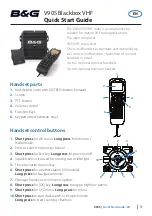
Page 5 of 90
CCT24
1.0 Introduction
The CCT24 series transceivers provide highly reliable wireless connectivity for point-to-point, point-to-
multipoint, peer-to-peer or tree-routing applications. Frequency hopping spread spectrum (FHSS) tech-
nology ensures maximum resistance to multipath fading and robustness in the presence of interfering
signals, while operation in the 2.4 GHz ISM band allows license-free use world wide. The CCT24 sup-
ports all standard serial data rates for host communications from 1.2 to 460.8 kb/s plus SPI data rates
from 6.35 to 80.64 kb/s. On-board data buffering and an error correcting radio protocol provide smooth
data flow and simplify the task of integration with existing applications. Key CCT24 features include:
•
Multipath fading resistant frequency hop-
ping technology with up to 38 frequency
channels per subband
•
Dynamic TDMA slot assignment that maxim-
izes throughput and CSMA modes that max-
imizes network size
•
Support for point-to-point, point-to-
multipoint, peer-to-peer and tree-routing
networks
•
AES encryption provides protection from
eavesdropping
•
FCC 15.247, IC and ETSI certified for
license-free operation
•
Nonvolatile memory stores CCT24 configura-
tion when powered off
•
10 mile plus range with omni-directional
antennas (antenna height dependent)
•
Selectable 1, 10 and 63 mW transmit power
levels
•
Transparent ARQ protocol with data
buffering ensures data integrity
•
Simple interface handles both data and
control at up to 460.8 kb/s on the serial port
or 80.64 kb/s on the SPI port
•
Analog and digital I/O simplifies wireless
sensing
•
Auto-reporting I/O mode simplifies applica-
tion development
1.1 Why Spread Spectrum?
A radio channel can be very hostile, corrupted by noise, path loss and interfering transmissions from
other radios. Even in an interference-free environment, radio performance faces serious degradation from
a phenomenon known as multipath fading. Multipath fading results when two or more reflected rays of the
transmitted signal arrive at the receiving antenna with opposing phases, thereby partially or completely
canceling the signal. This problem is particularly prevalent in indoor installations. In the frequency do-
main, a multipath fade can be described as a frequency-selective notch that shifts in location and intensity
over time as reflections change due to motion of the radio or objects within its range. At any given time,
multipath fades will typically occupy 1% - 2% of the band. From a probabilistic viewpoint, a conventional
radio system faces a 1% - 2% chance of signal impairment at any given time due to multipath fading.
Spread spectrum reduces the vulnerability of a radio system to both multipath fading and jammers by
distributing the transmitted signal over a larger frequency band than would otherwise be necessary to
send the information. This allows a signal to be reconstructed even though part of it may be lost or cor-
rupted in transmission.






































